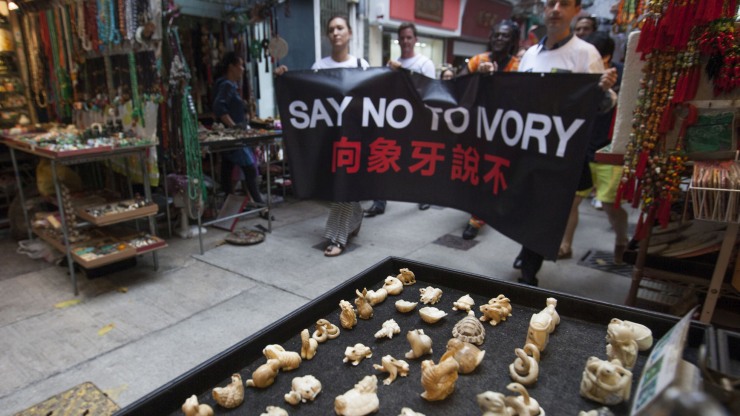By Peter Knights, Executive Director, WildAid
Hidden behind the superficial beauty and craftsmanship of many ivory products lies the ugly truth of their frequently brutal origins and sad history. This creamy material with its wood-like grain is a medium for detailed carving and has long been coveted, with disastrous implications for the world’s largest land animal.
In Roman times the desire for ivory wiped out north African elephant populations. Colonial times cut large swathes through West African populations from several countries, such as the Ivory Coast, as ivory was the “Victorian plastic”, providing piano keys, billiard balls, brush handles, and combs on an industrial scale to Britain and the United States.

In the 1970s and 80s international demand, especially from a newly-enriched Japan for hankos or stamps, decimated many central and east African populations. Most recently a market largely in mainland China led to a 60 per cent decline in forest elephants in just 10 years. Poaching rose to roughly 33,000 elephants a year.
That’s one elephant killed every 15 minutes to meet ivory demand.
Even ivory deemed “legal” before the 1989 ivory trade ban was often laundered ivory from poached elephants. In the 20 years preceding the ban more than 600,000 elephants disappeared into the trade. So you cannot be sure that any piece of ivory was not taken from poaching.
Beyond the destruction of elephant populations, the ivory trade has had a far-ranging impact. It has a direct relationship with some of the human race’s bloodiest periods of history.

As viewers of the movie “Apocalypse Now” may not know, the cinematic view of the horrors of war was based on Joseph Conrad’s novel “Heart of Darkness”, in which the original Kurtz was an ivory trader gone rogue, not a former soldier.
Ivory was intertwined with the ugly history of the slave trade in Africa, first through Arab traders and then through colonial times. Prince Leopold’s colonization of the Congo was an especially terrible time for the exploitation of humans and elephants. Ivory then became an international African currency.
Later the deplorable Apartheid government of South Africa smuggled ivory, along with rhino horn, to finance weapons and munitions for the anti-communist forces in Angola and Mozambique, greatly prolonging those civil wars. More recently Joseph Kone’s notorious Liberation Army has only survived through illegal ivory sales.

Ivory demand has also taken away millions of tourism dollars from countries that could greatly benefit from positive environmental programmes and revenue, while fuelling corruption across the continent. It is estimated that a single elephant in its lifespan can generate between US$1 million and US$1.6 million.
Beyond the monetary value is the national pride shared by Africans where elephants roam free across vast plains and in lush forests.
With all of this ugliness, the demand for ivory must be stopped at its epicentre and it is closer than you may think. The mass laundering of illegal ivory from poached elephants of the 1970s and 1980s took place right here in Hong Kong.
When the international ivory trade was closed in 1989, Hong Kong traders had stockpiled 700 tonnes of ivory representing tens of thousands of elephants, many of them killed by poachers. Now, 28 years later, Hong Kong’s traders still have 70 tonnes of ivory left and are asking for more than five years to sell it off, having first demanded public compensation.
It is the continued legal ivory trade that WildAid and many of my peers have seen fuelling the illegal trade, providing cover for pieces arriving in Hong Kong, some smelling strongly of the fresh blood still drying on them. Traders admit that local markets dried up years ago and most sales go to mainlanders who smuggle ivory back with them.

Thankfully, after centuries of destruction the end of the ivory trade may finally be nigh. President Xi’s announcement of a ban on ivory trade in China in one year has been praised around the globe, alongside America’s move to ban the trade.
There is no reason why Hong Kong could not do the same with a timeline shorter than the currently proposed five years. This would leave only Japan as a major legal market for ivory.
Beyond the bans, we can all do our bit by rejecting and stigmatising ivory. We can speak up for these beautiful creatures and refuse to accept gifts made from ivory. We can ask others to do the same and encourage conservation over extinction.
Ultimately the trade is driven by demand and when the buying stops, the killing can too.
WildAid is an NGO aiming to end the illegal wildlife trade.
